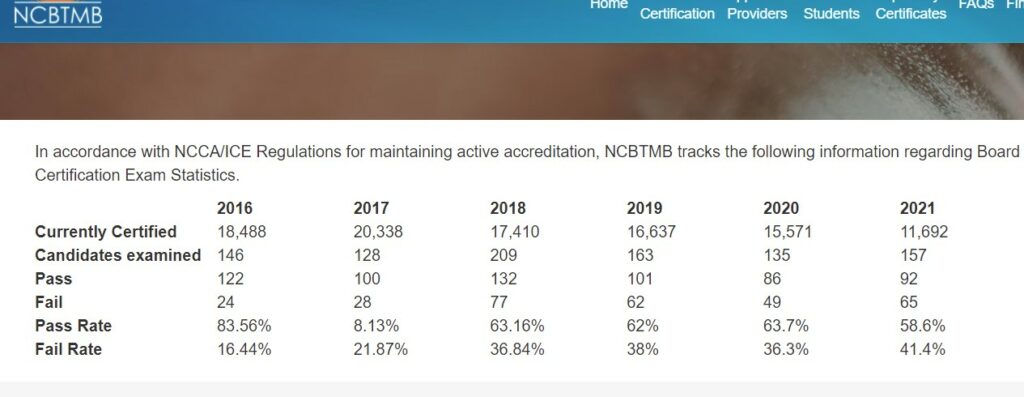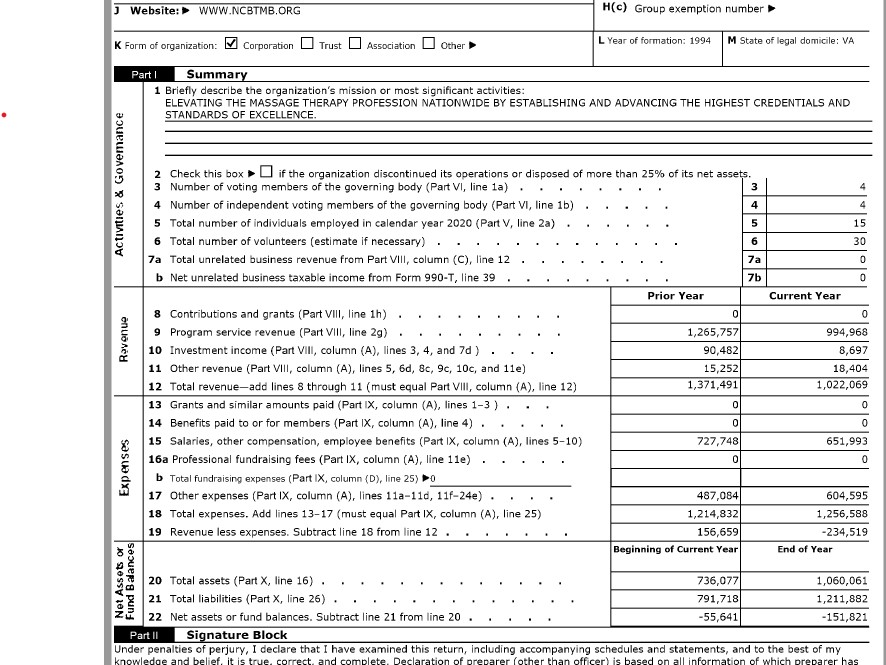Background: The National Certification Board in Massage and Bodywork is the organization that has created the Board Certification Exam and Credential in Massage and Bodywork back in the 1990’s.
The idea of having a national certification board was initiated by AMTA (American Massage Therapy Association) in 1988. AMTA gave $150,000 and later another $75,000 from their general funds to create an exam that was initially an entrance exam for AMTA potential members. Sometime and somehow, in 1989, the intentions changed and it became a national exam. Previously, AMTA had required an entrance exam if you had not graduated from an AMTA approved training program. AMTA had also had members include the words certified in their designation but in 1990, AMTA voted in Jan of 1990 to have members remove the word certify from the membership certificate and replaced it with “this is to verify that (Name) is an active member…” (Massage Therapy Journal, Spring 1990. Patricia Benjamin. Certification with a Capital C.)
In April of 1989, 60 massage therapists signed and sent a joint initiative to AMTA to stop the process until more information could be gathered regarding whether or not national certification was necessary for the profession. This was rejected by AMTA.
A steering committee was chosen by 4 AMTA officers. It consisted of 2 members of AMTA who initially proposed this action, Susan Rosen of Washington and Susanne Carlson of Oregon. Within the committee, 7 out of 9 members were AMTA members. The committee included Patricia Benjamin (IL), Susanne Carlson (OR), Raymond Castellino (CA), George Kousaleos (FL), Susan Rosen (WA), Grethcen Sakofshy (VT), Stenven Schenkman (NY), Benny Vaugh (FL), Ashley Montagu.
In May 1990, the steering committee declared that it was now separate from AMTA.
Massage Magazine in Jan/Feb 1991 reports that there were never any studies, surveys or reports done that established a need for certification. There was a survey of AMTA members asking whether or not they supported the action, but not not if the thought national certification was needed. 1,420 AMTA members responded of which 1,042 said they supported national certification. At the time there were approximately 60,000 therapists nationwide.
National Certification was developed in an effort to bring credibility to the profession. It’s intentions were to improve the status and image of the bodywork community. The exam would certify that certain educational and professional standard were met. The educational requirements were the bare minimum thought to be need to practice massage. The exam is based on a study done to find out what practitioners do and what they need to know.
The National Certification Exam was NEVER meant to be an exam that let you move state to state without having to take the exam in that state. It NEVER was a path to portability.
The History of the National Certification Board in Massage and Bodywork
I did an in depth look at the History of the NCBTMB and found it very interesting.
The history of the NCBTMB and exams has created a lack of trust in the organization. Massage therapists never got to see the benefit of having such a certification agency. A National Certifying Agency is one of the things that is needed to be known as a profession according to Rick Rosen author of many white papers for the massage profession. He states in his article The Structure of the Massage Profession:
While each mature profession has its own developmental history, culture, and methods of operation, there are six basic components that are common to all. These are: 1) membership association; 2) independent organization of colleges or schools; 3) accrediting commission; 4) federation of state licensing boards; 5) specialty certification boards; and 6) research center.
The NCBTMB is one of the important parts of the profession, but has consistently wavered in it’s mission.
Through the many years, the NCBTMB was faced with many struggles. The biggest challenge was suriving the battle over who would provide the licensing exam and who would control the CE approval process. The NCBTMB’s main income was from providing the licensing exam and also being the sole association that approved CE classes. The Federation of Massage State Boards came into being in early 2005. It was started by ABMP. In September 2005, FSMTB held its formative meeting in Albuquerque, New Mexico, prior to the annual American Massage Therapy Association (AMTA) convention. In 2009, AMTA dropped their support of the NCBTMB and announced that they supported the MBLEx and the FSTMB as the main licensing exam.
Where the NCBTMB is today: Feb. 5, 2022
The MBLEx is the main test for massage licensing in the US. The NCBTMB still offers their Board Certification in Therapeutic Massage and Bodywork (BCTMB®). They have created a list of approved massage schools that meet their requirements for Board Certification. The schools must provide a specific number of hours in each subject:
Our 500-hour curriculum requirements:
- 125 hours of instruction in the body’s systems and anatomy, physiology, and kinesiology
- 200 hours of in-class, supervised hands-on instruction in massage and bodywork assessment, theory and application instruction
- 40 hours of pathology
- 10 hours of business and ethics instruction (a minimum of 6 hours in ethics)
- 125 hours of instruction in an area or related field that theoretically completes your massage program of study
To become Board Certified, you must meet or exceed the following requirements:
- Graduation from a NCBTMB Assigned School*
- Passing score on the Board Certification Exam
- Pass a criminal background check
- Verification of current massage therapy state license
- Agree to uphold NCBTMB’s Standards of Practice and Code of Ethics
The cost to apply for Board Certification is $275
*If you did not graduate from a NCBTMB Assigned School, your school is now closed, or you completed international training, you may instead apply for Board Certification via Portfolio Review. Download the Portfolio Review Handbook here.
Current NCBTMB Stats: Pass Fail Rates and number of Board Certified MT.


The NCBTMB is also out of money and has been funded by AMTA for the last few years. I am not sure if they are continuing to be funded by AMTA at the present (02/06/2022). Their 990 form filed with guidestar.org says they are $151,000 in the hole as for the reporting period of 02/28/21.
How can we fix this?
As I have been researching this, I just keep hearing in my head – You had ONE job to do… how could one organization get so off track?
The current Board Certification in Therapeutic Massage and Bodywork (BCTMB®) does not require much more learning than most states require for massage licensing. Why would anyone want to pay extra when the exam/certification are meaningless? No one recognizes this exam as being above and beyond regular licensing. Not many even know this history or know much of anything about this organization. With that in mind, here is what I would recommend:
- Change the name of the organization! It was never a National Exam! It never meant that you could move between states.
- Increase the number of hours required to take the exam. 625 is the minimum that the ELAP requires to educate an entry level massage therapist. Many boards still only require 500 hours. Some are increasing their number of hours of education. A State Massage Board is only there to protect the public. It is not meant to promote or enhance the massage profession. That is what massage ASSOCIATIONS are for!
- I am not sure if the number of hours were increased that it would require that a new test be made. New tests are made all the time though.
- Create a National Awareness campaign to promote the Board Certification. Employers of spas, wellness centers, hospitals and every other employer would have to make it a requirement that their employees be Board Certified. Would it help weed out the massage therapists who are unethical, sex offenders and just awful massage therapists?
- Then start looking at the CE approval program. After spending the last year reading over 60 papers on CE/Professional Development, the massage profession has never really studied what is really needed in the realm of CE. I would love to see the CE classes be one class across the US that is required that keeps MT up to date on the latest news and gets everyone on the same page with the myths the profession has carried on for so long and keep up with the latest research.